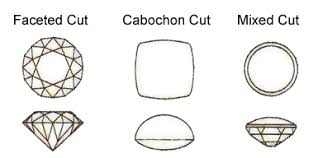Diamond Guide
Diamonds are not only ‘a girl’s best friend’, they can also be an excellent investment. When shopping around for diamond jewellery, the most important points to remember in terms of judging quality are the Four C’s – cut, carat, clarity and colour.
The following guide will explore these vital points, so you can be sure to buy diamond jewellery that you’ll treasure forever.
CUT
Diamonds are crystals made of pure carbon, so they are one of the hardest substances known to man. Because of their durable rigidity, the only object able to cut or carve a diamond is another diamond.
The way a diamond is cut is actually the most important factor in bringing out its optimal potential and for appraising its value. A well-cut diamond will have a glorious sparkle because it will reflect light spectacularly.
It must be pointed out however that there is a difference between the cut and shape of a diamond. The cut is all about the facets and angles embedded in the diamond to best reflect light and brilliance, whereas the shape refers to the actual geometric form after the jeweller has cut and polished the stone. Nevertheless, both the cut and shape of the final result are determined by a diamond’s inherent, natural dimensions.
The round-shaped, “brilliant” cut is arguably one of the best cuts to bring out a diamond’s beauty, so it has traditionally been one of the most popular.
The following guide will explore these vital points, so you can be sure to buy diamond jewellery that you’ll treasure forever.

Carat
Carat refers to the traditional unit of measurement for gemstone weight – it is the equivalent to one-fifth of a gram. While diamonds that are large in carats will obviously tend to be more expensive, the cut and clarity will also affect their pricing significantly.

Clarity
By nature, most diamonds have inclusions or flaws. These are often invisible to the naked eye, however this factor will affect their valuation by a jeweller as well as the flow of light which makes the stone dazzle.
Thus, the level of diamond clarity is important and is measured in a particular grading system to define the level of flaws inherently present. Diamonds with no flaws are extremely rare and are graded as FL (flawless) or IF (internally flawless).
This is the grading system for the degree of flaws that affect the clarity of diamonds:
- Imperfect (Flaws visible to the naked eye): I1 – I3
- Slightly Imperfect (smaller flaws): SI1 –SI2
- Very Slightly Imperfect (tiny flaws): VS1 –VS2
- Very Very Slightly Imperfect (miniscule flaws): VVS1 –VVS2

Color
A chemically pure diamond will be perfectly transparent, with no hue or colour, however the fact is that absolutely pure, naturally formed diamonds are practically non-existent, they all have trace elements of yellow or brown inherent in them.
The colouration of diamonds will play a large role in their valuation, since the more impurities that a white diamond contains, the less it will be worth.
On the other hand, certain impurities such as nitrogen atoms within the carbon frame of diamonds can actually add to their value. Black, pink, blue, green and yellow diamonds, especially those with more intense colouration, are extremely rare and thus tend to be pricey.
Diamonds colours are graded on a scale that ranges from D (colourless) to Z (a light yellow). The colourless diamonds rated D, E and F are the best grade in their class, and the price tag will reflect this. It must be remembered however that a quality diamond will not simply have a top grade for colour, it must also have good clarity and cut to showcase its brilliance and sparkle.

